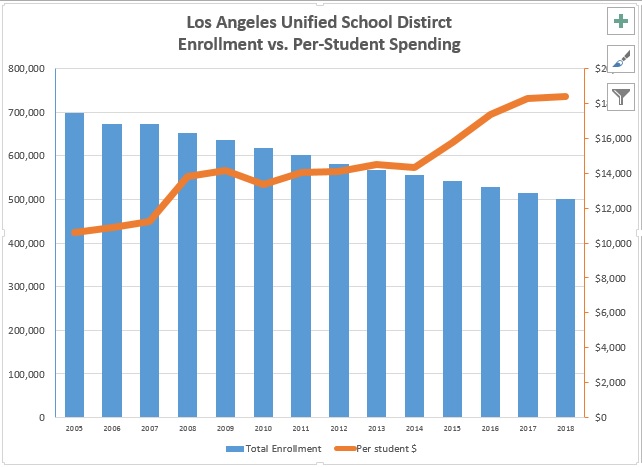L.A. Teachers, School District Reach Deal To Possibly End Strike
The LAUSD has seen a 16 percent jump in administrative staffers since 2004-and per pupil spending has been marching steadily upwards.

An agreement has been reached that could end a week-long strike by some 30,000 teachers in the Los Angeles Unified School District (LAUSD), though details will not be released until after union members vote on the deal later Tuesday.
If approved, teachers could return to the classroom as soon as Wednesday, the Associated Press reports.
As you might expect, the strike is ultimately a disagreement over money. The union is demanding a 6.5 percent pay increase for all teachers, while the district has offered a 3 percent raise this year followed by another 3 percent raise in 2020. But the union is also asking for the LAUSD to spend larger sums of money on non-teaching staff and to hire more teachers in order to reduce class sizes. District administrators say that giving into those demands would hasten the LAUSD's descent into insolvency.
On its current trajectory, the school district will face a $422 million shortfall by 2020, driven in large part by its $15 billion in unfunded health care benefit liabilities for current workers and retirees. A task force that studied the district's fiscal condition in 2018 concluded that the structural deficit "threatens its long-term viability and its ability to deliver basic education programs."
Even if the district was not facing those massive bills for pension costs and retiree healthcare, the call for more hiring should be greeted with skepticism at a time when LAUSD is seeing enrollment decline. The total student enrollment in LAUSD schools has dropped from around 700,000 in 2005 to just over 500,000 last year, according to the district's own comprehensive annual financial reports.
Meanwhile, hiring has been on the rise—the LAUSD has seen a 16 percent jump in administrative staffers since 2004—and per pupil spending has been marching steadily upwards.

These numbers include only students enrolled in district schools and the district's spending on those schools. In other words, charter school students and the costs of running charter schools are excluded.
"The district is spending close to $17,000 per student—about 50% more than it was at the beginning of the decade," says Marc Joffe, an education policy analyst for the Reason Foundation, which publishes this blog. "If this money was more fully directed to the classroom, it should be enough to provide adequate teacher compensation and reasonable class sizes."
Spending more money to cut class sizes when student enrollment is already falling seems like a mistake. The decline is driven by a combination of factors, including the explosive growth of charter schools in Los Angeles and a growing number of families that are leaving the district to seek education in other public schools. Those are trends that are unlikely to be reversed by the LAUSD digging a larger hole for itself by hiring additional employees—all of whom will be owed pension and health care benefits, the two costs that are already dragging the district down.
Spending more money is not a surefire way to improve schools. As Stan Liebowitz and Matthew Kelly, a pair of researchers at the University of Texas, explained in a recent Reason cover story, student performance is not correlated with per-student expenditures.
Indeed, holding down pay in a district where the average teacher already earns more than $84,000 may have kept the LAUSD out of this fiscal hole in the first place. If raises for LAUSD teachers had been held to only 1.5 percent since 2014 (when the most recent contract between union and district was signed), Los Angeles public schools would now have an extra $352 million dollars a year to spend on education, according to an analysis by the California Policy Center, a center-right think tank.
The district could save $300 million per year by shifting retirees onto Medicare—an imperfect solution that would move those costs from district taxpayers to federal taxpayers, but one that would save the LAUSD money nonetheless.
Any of those options should be on the table as the LAUSD tries to get back on track. About the only thing that the district should not consider, given the current trajectories for student enrollment, long-term costs, and per-pupil spending, is hiring more workers on the public's dime.


Show Comments (14)